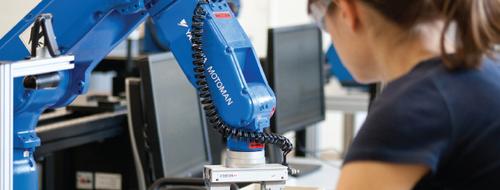The Gaping Skills Gap in Advanced Manufacturing
A panel session on the advanced manufacturing workforce at the Pacific Design and Manufacturing show in Anaheim this week revealed a major skills gap.
February 10, 2016
As manufacturing gets smarter with Industry 4.0 and the ever-expanding Industrial Internet of Things, the workforce skills needed to deploy new technology are falling behind. Baby Boomers are retiring and taking their decades worth of experience out the door, while the newly graduated engineers are not prepared for the brave new world of smart plants.

(Source: mccnh.edu)
Industry leaders addressed this challenge at the Pacific Design & Manufacturing Show in Anaheim this week during a session called, “No Worker Left Behind: Optimal Integration of Industrial IoT with the Human Work Force.” The looming problem, according to the presenters, is that there is simply not enough skilled talent to run advanced plant technology. “We’ve been lucky that we have large research organizations with a focus on manufacturing technology, but it’s not scalable,” said Julian Keith Loren, director of external engagement and solutions at GE Software. “You can draw on it for the first few plants, but it doesn’t scale for 500 factories. It’s a real challenge. How do we get the right people and scale?”
Filling the Skills Gap
The skills-gap problem is accelerating with the retirement of Baby-Boomer engineers who are reaching retirement age. They’re taking their accumulated technical expertise out the door when they leave. “The knowledge is in the head of our senior engineer and they’ve soon to retire,” said Loren. “The skills and tribal knowledge is going out the door and we have to have those skills coming in.”
The skills deficit was intensified by lay-offs during the economic downturn a few years ago. “During the recession, a lot of plant-level people with skills were let go, so the skills-gap increased,” said Paul Heine, strategic business development at SICK Inc. “The people who filled that gap were the system integrators, coming in from outside.”
Another way to deal with the skills gap is to create technology that requires less from its users. “The development of plug-and-play technology always needs to be there. Initially we made one product. Now we have to make two products, one for the uneducated user and one for the super user,” said Heine. “The dynamics for these products are changing. We have to understand what type of education is required to use our products.”
READ MORE ARTICLES ON THE PACIFIC DESIGN & MANUFACTURING SHOW:
Keeping engineers up on new technology is a continuing challenge as the technology itself keeps expanding. “You need to train every worker on the skills that are necessary, adapting the workforce to the technology, and it’s not just what’s happening on the floor,” said Rob Bodor, VP and general manager at Proto Labs. “Software is the digital thread going through all automation. A big percentage of our base is software and that’s as important as the machinery on the floor.”
Manufacturing Isn’t Sexy
Part of the challenge for plant managers is the fact that the idea of a life in factory automation may not sound attractive to young engineers. “Attracting talent is a challenge. Manufacturing isn’t sexy,” said Bodor. “The GE commercials are hilarious and they break through that, but we have to do more to change that mindset about manufacturing. The other piece is we have to grow our own and put programs in place.”
Educating students to the benefits advanced manufacturing wages might make a difference in student interest. “I visited a vocational school with 700 students. In advanced manufacturing, they had only 38 students. The advertising track had 131. Yet I’ve never met a graphic designer who makes more than $35,000 a year. In advanced manufacturing, the beginning wage is $47,000,” said Brian Fortney, global business manager of workforce development and training at Rockwell Automation.
The Future Tech Looks Bright
The panelists see hope in the future as universities get better about communicating the benefits of careers in advanced manufacturing technology. “I’m optimistic about university partnerships. We tend to focus on target markets that we know are growing, such as robotics and guided vehicles,” said Bodor. “We find people who are intrinsically motivated to success. The intention is to get the motivated students involved.”
One panelist sees the far future as very bright. “I’m very optimistic about the workforce as it grows into 2020, 2030, and beyond. The folks coming into the workforce now are adept at multiple technologies, including the digital thread that runs through all manufacturing,” said Fortney. “They’re seeing images instead of words. That velocity of technology change is increasing but they’re ready for that.”
Rob Spiegel has covered automation and control for 15 years, 12 of them for Design News. Other topics he has covered include supply chain technology, alternative energy, and cyber security. For 10 years he was owner and publisher of the food magazine Chile Pepper.

About the Author(s)
You May Also Like


.jpg?width=300&auto=webp&quality=80&disable=upscale)


